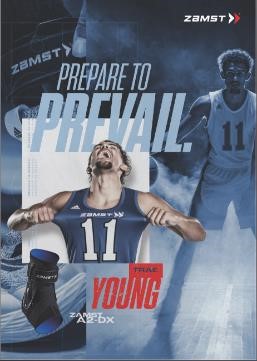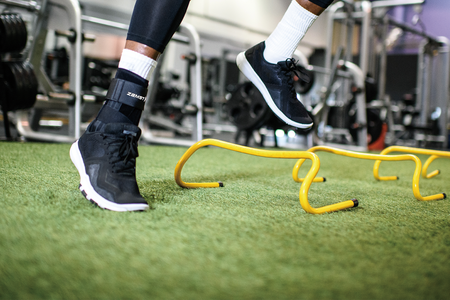One of the main differences between a low ankle sprain and a high ankle sprain is the recovery timeline. In general, high ankle sprains take much longer to heal and come back from than lower ankle sprains depending on severity. While low ankle sprains represent 90% of all ligament injuries to the ankle, high ankle sprains can be the most concerning. Football represents a significant portion of high ankle injuries because of the level of contact in the sport. Typically, high ankle sprains occur from external rotation forces that cause the talus to rotate laterally which pushes the fibula away from the tibia causing separation of the high ankle joint (syndesmosis). Most recovery options are non-surgical but there is a newer surgical procedure that speeds up the healing time.
How long does it take to recover?
The recovery timeline and returning to sport is what separates low ankle sprains from high ankle sprains. Depending on severity the recovery timeline can range from weeks to months. Severity is typically determined by imaging and consists of grades.
Grade I: Ligament is stretched but not torn
Grade II: Ligament is partially torn
Grade III: Ligament is completely torn
Healing times vary but also are dependent on severity of sprain
Grade I: 1-4 weeks
Grade II: 4-8 weeks
Grade III: 3-6 months and surgery might be an option
The tough part with the recovery timeline for high ankle sprains is the instability between the tibia and fibula (syndesmosis area). This can become very painful when there is too much separation and it will impact jumping, cutting, sprinting and landing. When you get into the Grade II-III severity ranges surgery may be an option depending on instability and sport.
What are the treatment options for high ankle sprains?
Conservative approach
This usually starts with some form of immobilization to allow for the ankle joint to heal. A brief period of immobilization for up to 2 weeks using a controlled ankle movement (CAM) boot to protect weight bearing force during the acute period appears beneficial1. During this time working on mobility, stability and strength is key to helping with recovery time. Blood flow restriction (BFR) training can be key during the immobilization period because it allows for open kinetic chain activities for strength gains. After this point the athlete should be able to perform painless single heel raises and single leg hops in order to test running and cutting. If running and cutting are pain free, then they can return to practice. For stable syndesmotic injuries a full return to competition can range between 2-6 weeks.
Surgery approach
When a high ankle sprain is unstable such as a severe grade II-III sprain surgery may be an option for faster recovery or to correct the instability. If the syndesmotic space between the tibia and fibula has widened too much the corrective surgery can be an option. Traditional approach involves inserting 1-2 screws between the tibia and fibula to allow for proper healing of the syndesmosis area between the tibia and fibula. One issue with the screws is that it can limit your mobility and some surgeons will remove screws once healing time has been reached which would be another surgery.
A New Surgery Technique
If you are a big fan of college football and the University of Alabama, you might have heard of the “tightrope procedure.” It is a relatively new procedure for high ankle sprains that speeds up the recovery time. Tua Tagovailoa who injured his ankle before the college football playoffs in 2018 had this procedure done and was able to play in the college football playoffs 28 days later! This procedure involves drilling across the two bones (Tibia and Fibula) and placing a non-absorbable suture construct with metallic buttons at either end creating the “tightrope.” This will hold the two bones closer together while providing the ligament stability. This will allow for the area to heal and provide the athlete with a chance to return early to their sport. There is moderate evidence to support the use of the tightrope procedure as it provides outcomes similar to using conventional screw with a shortened time to recover and return to activity2.
How is the long-term recovery prognosis?
Overall prognosis for high ankle sprains is good with returning to sport. However, once a person has sprained an ankle it increases the likelihood of another sprain because of the instability of the ligaments. This gives an individual more of a reason to add some layer of protection after suffering an ankle sprain. The Zamst A2-DX provides significant support after an injury by giving someone max stability while allowing for normal mobility in sport. Stephen Curry and Trae Young have been early adopters of the Zamst A2-DX ankle brace which has really helped their availability on the court. They are true believers of adding a layer of protection and reducing their risk for severe ankle sprains. Once ligaments have been stretched too far it decreases stability in the ankle joint. Zamst ankle braces are a way to provide significant support without giving up mobility.

Learn more about WHY TRAE YOUNG USES THE ZAMST A2-DX and about the entire Zamst ankle brace lineup.
ABOUT THE AUTHOR
Dr. EVAN JEFFRIES is a physical therapist with a Doctorate in Physical Therapy (DPT) from the University of St. Augustine for Health Sciences. He is also the owner of Evolving Motion and has vast knowledge of the musculoskeletal system and has treated many orthopedic conditions by bringing a proactive approach to healthcare and lifestyle. Recently he has also been active on social media as an injury analyst mainly in related to injuries NBA players have sustained. Evan can be followed on his social media accounts.
- Knapik DM, Trem A, Sheehan J, Salata M, Voos J. Conservative Management for Stable High Ankle Injuries in Professional Football Players. Sports Health. 2018 Jan-Feb; 10 (1): 80-84.
- Street SB, Rawlins M, Miller J. Effectiveness of the TightRope Fixation in Treating Ankle Syndesmosis Injuries: A Critically Appraised Topic. J Sport Rehabil. 2021 Feb 24;30(4):676-679.






